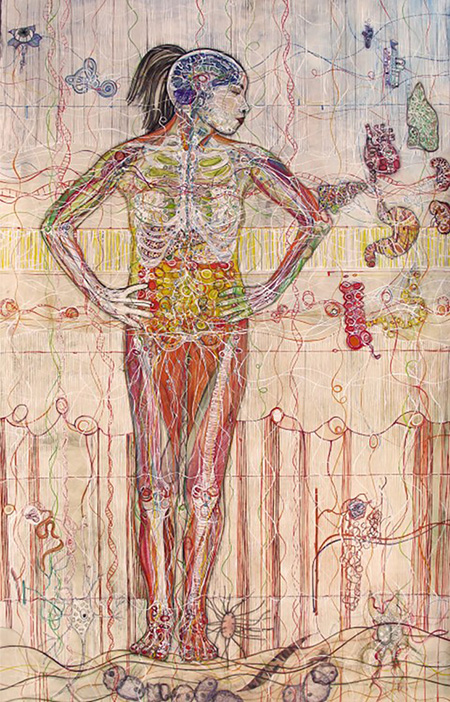
Continuing through August 7, 2022
Monica Aissa Martinez works at the intersection of art, science, and biography, drawing human figures and biological forms that challenge us to consider realities and relationships beyond the superficiality of contemporary culture. Dozens of her works, spanning the years 2015 to 2022, are featured in “Nothing In Stasis,” which pairs small mixed-media studies on flat wooden or acrylic discs with larger-scale studies that include portraits on canvas or Arches paper. Collectively, these works speak both to the long art historical tradition of anatomical studies and advances in scientific technology that make it possible to explore unseen worlds within and beyond the human body.
Before entering the gallery one sees a wall filled with mixed media tondos from Martinez’s series “Neglected Tropical Diseases.” She renders select parasitic organisms and their hosts primarily on discs of recycled wood ranging from 5 1/4 to 11 1/2 inches in diameter, using materials that include acrylic, casein, gesso, graphite, ink, micaceous iron oxide, and more. Subject matter ranges from the Aspergillus fungus to the Yersinia Pestis bacteria that causes plague. As with other studies, these works bring specificity to conceptions of interconnections within nature. They serve as meditations on the perils of ignoring those connections.
Pieces from two additional series, shown in display cases, make up the bulk of the exhibition. “A Concoction of Small Life” (2018-2020) includes eleven discs made with similar materials and titled after subject matter such as bacteria, blood cells, viruses, a gene, an amoeba, and brown adipose tissue. Most notable is “Coronavirus - When It Rains, It Pours,” a study completed during the first year of the COVID-19 pandemic. “Bones of the Cranium” includes a six-work “Braincase” series (2018) with 9 1/2-inch-diameter drawings of specific bones done with casein, gesso, graphite, ink, micaceous iron oxide, Prisma pencil, mylar, acrylic discs, and bolts.
The earliest piece, 2015’s “Handstand: Supporting Systems” (65 x 90 inches), positions a woman doing a handstand between a standing male figure and a cat. As elsewhere, its unclothed figures are rendered as complex biological forms using both realistic and abstracted imagery. Striking portraits of the artist’s parents reference their unique medical histories; and a portrait of her brother includes a map collage showing the El Paso streets where they grew up. “Portrait of Carolyn, Study of an Ecology” explores the physical traits, wellness practices, artistic impulses, and habitat of a close friend and fellow artist.
Symbolism abounds in this exhibition, where one work features a baby positioned near a butterfly that represents change. Other works broaden the view beyond individual bodies and the specificity of their contexts, to consider shared anatomical features such as a portion of the human brain called the optic chiasm. Thus Martinez calls to mind shared characteristics within and beyond species as well as the existence of unique traits, while also elevating the beauty of diversity.
“Nothing In Stasis” heightens our awareness of connections between microcosm and macrocosm at the cellular and societal level, pointing the way towards more expansive empathy amid the effects of pandemic isolation, on self and others. QR codes link to sections of the artist’s blog that correspond to particular works, illuminating the ways those pieces embody her own autobiography, which includes not only myriad connections across communities and fields of study, but also her own devastating loss tied to the pandemic. With this exhibition, which grew out of an artist-submitted proposal, Martinez and the museum poignantly elevate the liminal space between interior and exterior landscapes, suggesting a way forward that includes both self-care and greater consideration of the expansive web of interdependent life.
